Best laptops for engineering students 2024


Calling all engineering students! If you’re in the market for a laptop that can handle resource-intensive coursework, you’ve come to the right place. These laptops offer reliable performance as well as a portable form factor, which is important for when you’re running from class to class. We’ve also included budget-friendly machines and gaming rigs for those late night gaming sessions. Read on to learn more.
Why you should trust us: Hey, it’s in our name! PCWorld prides itself on laptop experience and expertise. We’ve been covering PCs since 1983, and now review more than 70 laptops every year. All of the picks below have been personally tested and vetted by our experts, who’ve applied not only performance benchmarks but rigorous usability standards. We’re also committed to reviewing PC laptops at every price point to help you find a machine that matches your budget.
Looking for great laptop deals? Check out our regularly updated list of the best mainstream, gaming, and 2-in-1 laptop deals. By the way, since we’re in the middle of back-to-school season, be sure to check out PCWorld’s extensive back-to-school coverage for advice and deals.
Quick retail links to our favorite laptops:
Best overall: Dell Inspiron 14 Plus (2024)Best battery life: Lenovo ThinkPad T14s Gen 6Best budget option: Acer Aspire Go 15
Updated November 5, 2024: We replaced the Best Ultraportable pick with the Asus Zenbook S 14 ($1,499.99), which features the latest Intel Core Ultra 7 258V (aka Lunar Lake) processor. Not only does it offer phenomenal battery life (up to 21 hours!), but it’s also incredibly lightweight. We also updated our list of recent laptop reviews, so be sure to check those out near the bottom of the page.
The best laptops for engineering students
Dell Inspiron Plus 14 – Best overall
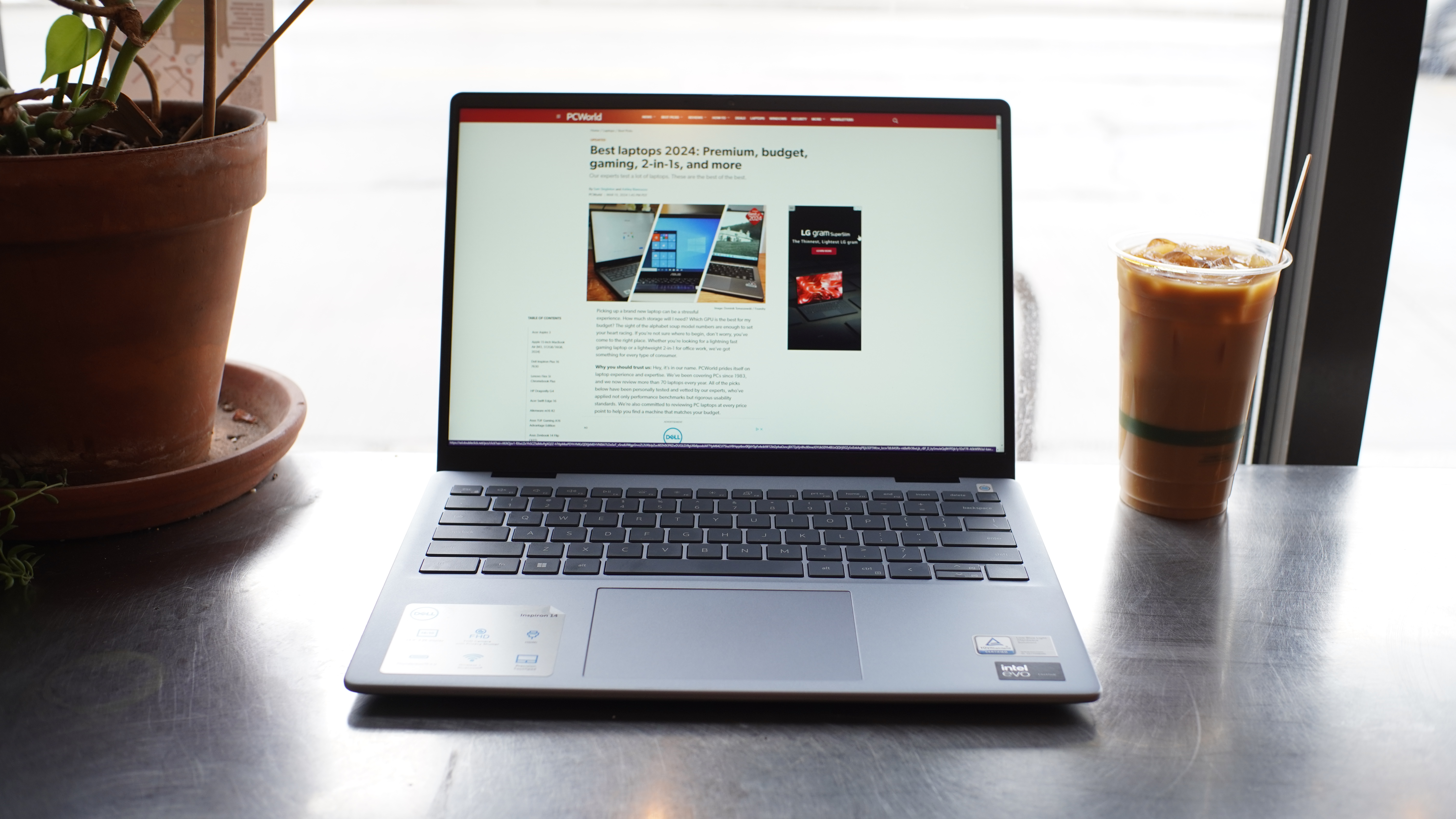
Pros
Strong performancePhenomenal battery lifeFantastic typing experience
Cons
CPU throttles under very heavy loadsNo user upgrades
Why we like the Dell Inspiron Plus 14
The Dell Inspiron 14 Plus is one of the most well-rounded laptops we’ve come across in recent months. This sub-$1,000 machine offers reliable performance, phenomenal battery life, and a gorgeous display. You really can’t get much better than that. With an exceptional PCMark 10 score of 7,061, it toppled comparable machines like the Acer Swift Go 14 and the more expensive Lenovo ThinkPad X1 Carbon. This laptop also has a battery life of 17 hours on a single charge (a spectacular result!), so you don’t have trouble yourself with finding a wall outlet to juice up.
Who should buy the Dell Inspiron Plus 14
Anyone looking for a laptop that checks off all the right boxes. Battery life and overall performance are outstanding, sure, but don’t forget about the gorgeous 14-inch 1400p display, which is “exceedingly well suited to office work and static imagery,” according to our review. It has a maximum brightness level of 418 nits and an anti-glare coating, so you can use this laptop in various lighting conditions. The design is far from sexy, but its hardware capabilities and amazing battery life make up for the uninspired aesthetics.
Alternative option: If you’re willing to shell out the extra cash, the Lenovo Yoga Pro 9i ($1,699.99) is a more premium option. It’s loaded with a faster processor (Intel Core Ultra 9 185H), more RAM (32GB), and a higher resolution display (3200×2000). It also has a bigger screen that measures 16 inches and a killer keyboard. You can’t really go wrong here if you need high-end power for high-end engineering tasks.
Read our full Dell Inspiron 14 Plus review
Lenovo ThinkPad T14s Gen 6 – Best battery life

Pros
Remarkable battery lifeA great array of portsSturdy, lightweight designHigh-visibility display
Cons
Variable performance trails competitiorsA bit pricier than the competition
Why we like the Lenovo ThinkPad T14s Gen 6
The Lenovo ThinkPad T14s Gen 6 lasted a jaw-dropping 24 hours on a single charge. That’s a bonkers result, and I mean that in the best way possible. This is partly due to the Qualcomm Snapdragon X Elite X1E-78-100 processor, which is more power-efficient than Intel or AMD processors. The other factor is the lower-resolution 1920×1200 display. It doesn’t have a high refresh rate or a fancy OLED panel, so it doesn’t impact the battery much. In addition to the extraordinary battery life, it’s also lightweight at 2.66 pounds — it’s designed to be taken with you everywhere.
Who should buy the Lenovo ThinkPad T14s Gen 6
Anyone with a jam-packed schedule. The Lenovo ThinkPad T14s Gen 6 is both long-lasting and portable, making it an ideal choice for a busy college student. That said, the keyboard is just okay and the display isn’t the sharpest we’ve ever seen, so you’ll need to keep those trade-offs in mind. If you’re not a big fan of the keyboard or display, you can always plug into external ones. This laptop has a decent port selection that includes a full-sized HDMI 2.1 port and a combination of Type-A and Type-C ports, so you shouldn’t have a problem hooking up to those peripherals.
Read our full Lenovo ThinkPad T14s Gen 6 review
Acer Aspire Go 15 – Best budget option
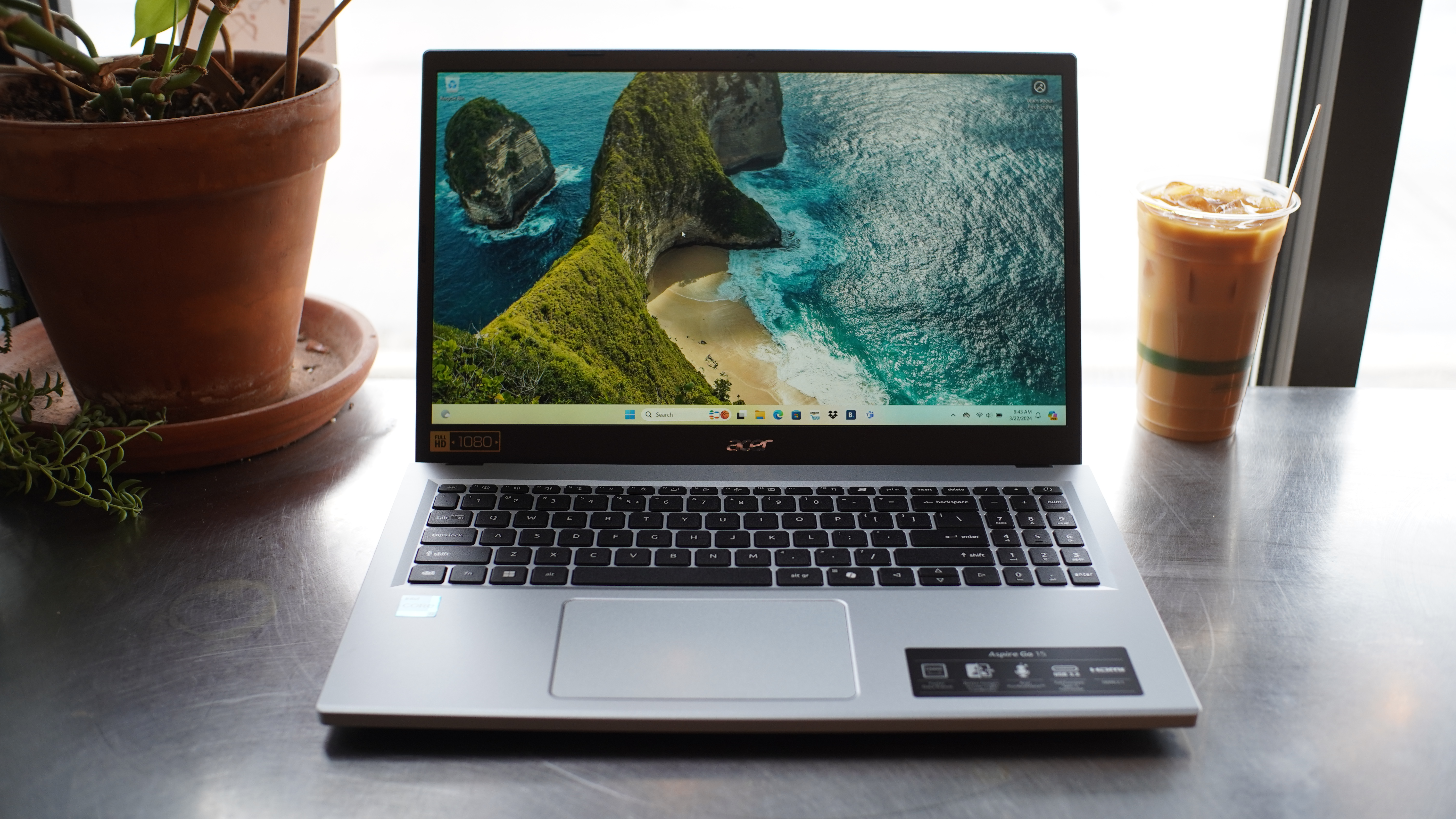
Pros
AffordableDecent battery lifeGood display visibility
Cons
Big and bulkyCheap buildLimited performance
Why we like the Acer Aspire Go 15
The Acer Aspire Go 15 is a great laptop for day-to-day tasks like general web browsing, watching a streaming service, Microsoft Office, and so on. The Intel Core i3-N305 CPU won’t be able to handle more demanding applications, but that shouldn’t be a problem as long as your use is relatively light. The 53 watt-hour battery, however, lasted 12 hours on a single charge–a respectable result and definitely more than a full school day.
Who should buy the Acer Aspire Go 15
Anyone on a tight budget! It’s just $300 right now on Acer’s online store, a great value for a laptop with a 15.6-inch 1080p display. It isn’t stretched too thin for clarity and it even has decent contrast, which is hard to come by on a laptop priced this low. The port selection is pretty good, too. You’re getting USB-A, USB-C, HDMI, a Kensington lock slot, a 3.5mm headphone jack, and a DC power adapter.
Acer Nitro V 16 – Best for work and gaming on a budget
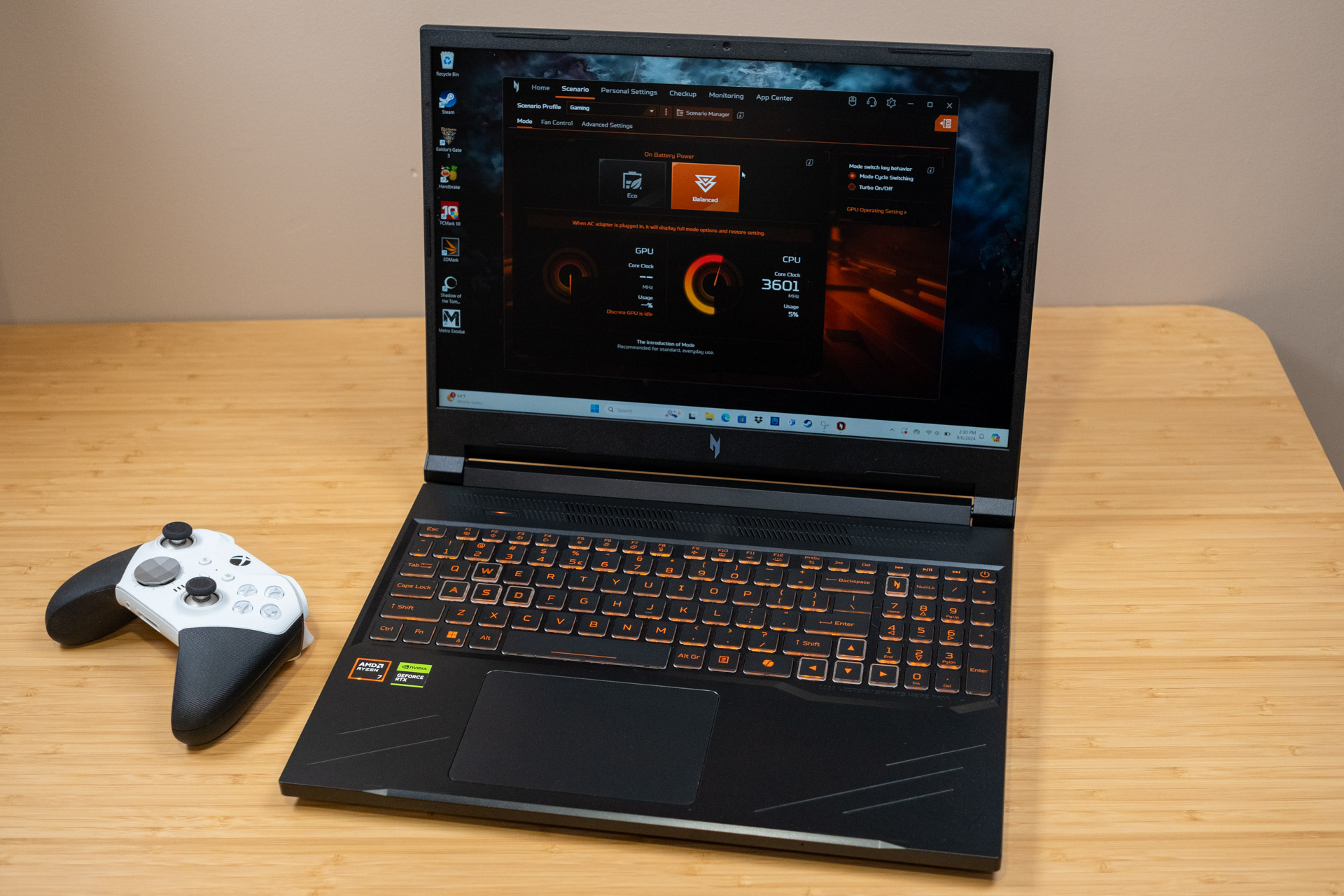
Pros
Solid performanceCompetitive priceDedicated button for quick performance mode switchingFast 165Hz display with good colors
Cons
Fully plastic buildMushy keyboardWeak battery life
Why we like the Acer Nitro V 16
The Acer Nitro V 16 offers a lot of value for the hardware and performance. It has an AMD Ryzen 7 8845HS CPU and an Nvidia GeForce RTX 4060 GPU, which is more than enough power to run games on the Medium or High graphics presets. The 1920×1200 IPS display is also big (16 inches!) and fast (165Hz), so it’s the perfect screen for those twitchy games in which every second matters. It’s a good value, but you’ll be tethered to an outlet, as the 56 watt-hour battery lasted about four hours on a single charge. That’s not a surprising result for a gaming laptop, especially one with a 16-inch screen.
Who should buy the Acer Nitro V 16
Anyone who needs a laptop that can handle schoolwork as well as gaming. The RTX 4060 graphics gives it the kick you’ll need for most modern games and the high refresh rate display will ensure that gameplay is nice and smooth. The keyboard isn’t the best and the whole thing is made of plastic, so it doesn’t have the most premium feel to it, but if you can overlook those nitpicks and strictly focus on the hardware inside, then you can’t get a better value than this.
Read our full Acer Nitro V 16 review
Asus Zenbook S 14 – Best ultraportable
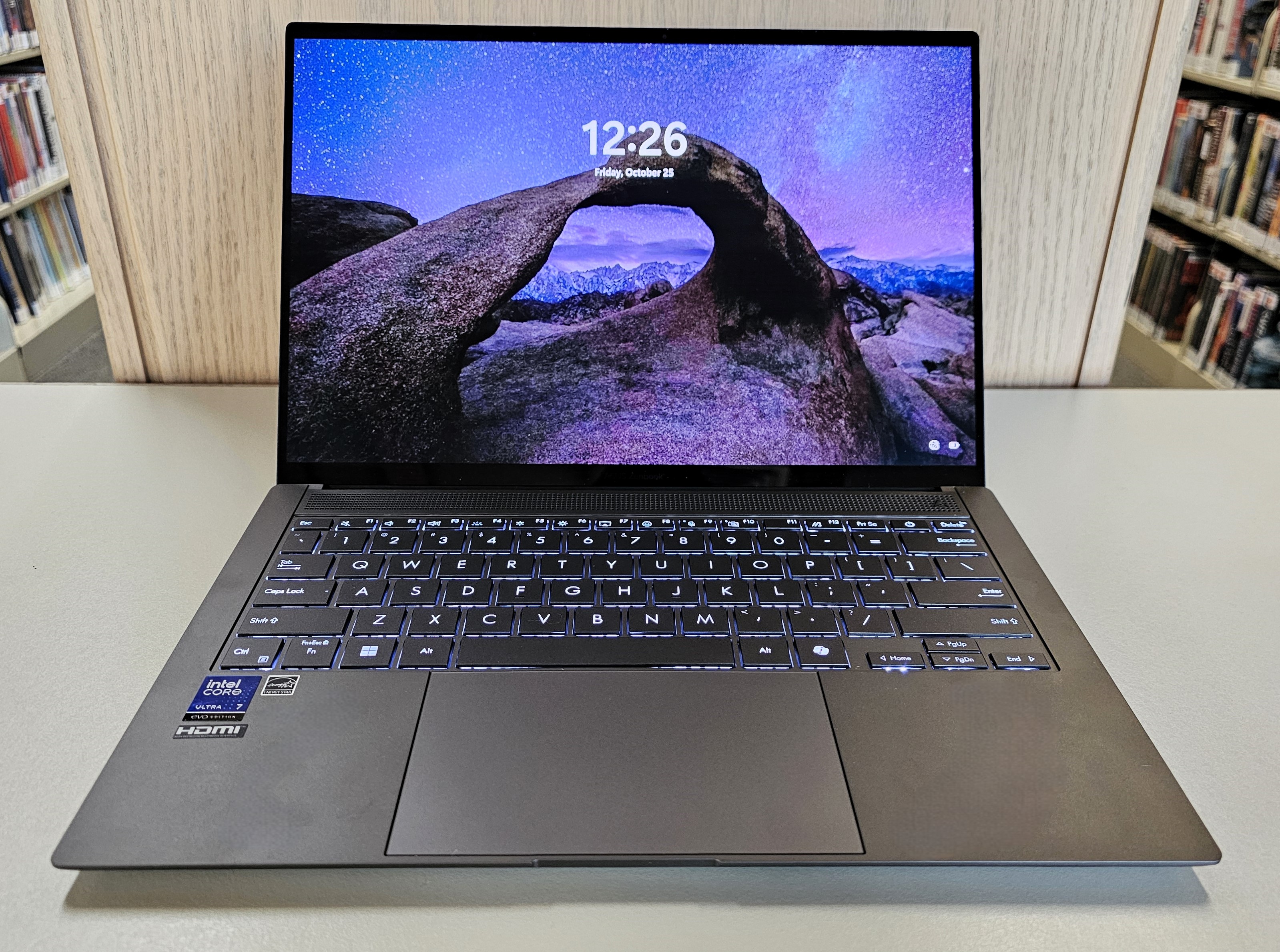
Pros
Transcendent battery lifeA purposeful use of spaceLovely, surprisingly large OLED screenGreat audio
Cons
Keyboard needs more key travelPerformance needs improvement, especially on batteryBest Prices Today: $1499.99 at Asus
Why we like the Asus Zenbook S 14
The Asus Zenbook S 14 is featherlight at just 2.65 pounds, which is lighter than the comparable 13-inch MacBook Air (2.7 pounds). It’s also structurally sound, which is surprising given how light and thin this laptop is. According to our review, there’s a “minimal of flex when pressing hard upon the center of the keyboard and the display doesn’t demonstrate meaningful wobble.” The featherlight form factor is great, but the battery life is something else entirely. The Zenbook S 14 lasted a spectacular 21 hours on a single charge! Excuse me while I pick my jaw up off the floor.
Who should buy the Asus Zenbook S 14
Anybody that’s looking for a compact productivity powerhouse. In addition to the lightweight form factor and fantastic battery life, the Zenbook S 14 also has a beautiful OLED touch display. The resolution is a sharp 2880×1800 and the refresh rate is a fast 120Hz. The fast refresh rate is ideal for smoother inking and mousing, and it makes it easier to look at the screen for longer periods of time. Finally, let’s end with the aesthetics. The silvery cracks on the lid resemble the silk of a spiderweb, which is unique and a real standout (in my opinion).
Read our full Asus Zenbook S 14 (UX5406SA) review
Asus Zenbook 14 OLED – Best OLED laptop

Pros
Robust build qualityAttractive OLED touchscreenGood CPU and integrated GPU performanceOutstanding battery life
Cons
Uninspiring designKeyboard isn’t memorableMediocre connectivity options
Why we like the Asus Zenbook 14 OLED
The Asus Zenbook 14 OLED dazzled us with its peppy CPU performance, outstanding battery life, and slick-looking OLED touchscreen display. According to our review, “movies and games look realistic and vibrant” on the 14-inch 1980x1200p OLED touchscreen, although it can be difficult to view content in brighter environments because of the reflective surface. It also died at the 16 hour mark on a single charge, which is absolutely fantastic. That result outclasses comparable machines like the Lenovo Slim 7 14 Gen 9 and the HP Pavilion Plus Laptop 14. As for how it performs, you should have zero problems zipping through real-world tasks like web browsing, video conferencing, and so on.
Who should buy the Asus Zenbook 14 OLED
Anyone that’s looking to pick up an affordable laptop with an OLED display. It’s so much more than that, though. The build quality is solid and day-to-day performance is both fast and responsive. Connectivity options are a bit limited, but that’s not unusual for a laptop in this price range. Overall, this is an exceptional budget laptop, as you can’t really beat the price to performance ratio.
Read our full Asus Zenbook 14 OLED review
MSI Titan 18 HX – Best high-performance laptop
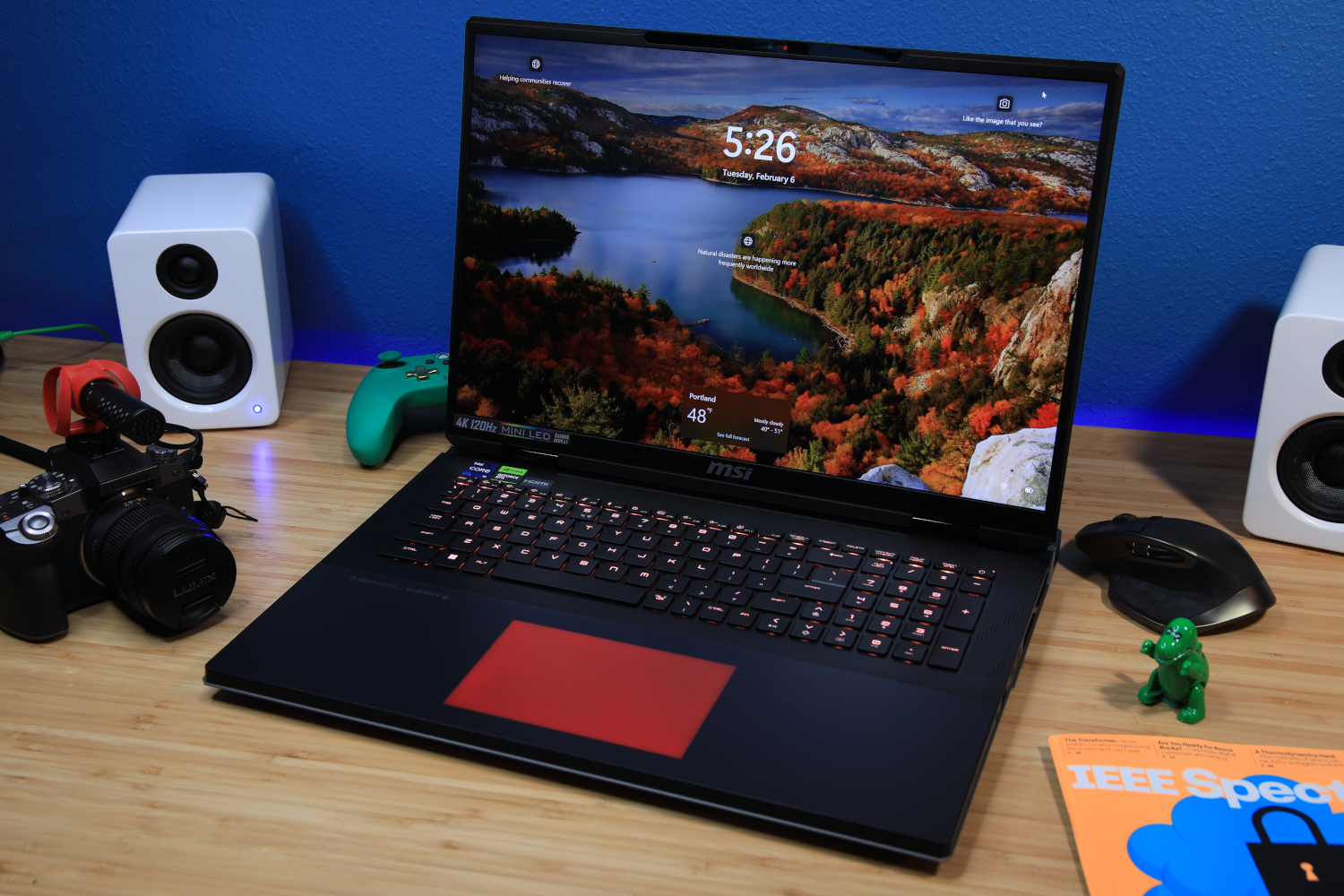
Pros
Robust build qualitySuperb 4K 120HZ Mini-LED displayExcellent mechanical keyboardExtraordinary CPU and GPU performanceLots of connectivity
Cons
Large and heavyAttractive but mediocre touchpad
Why we like the MSI Titan 18 HX
Sometimes engineering majors need a laptop with extreme computing powers, especially if the focus is on video editing or 3D modeling. If this is the case, the MSI Titan 18 HX is the nuclear option. It boasts a powerful Intel Core i9-14900HX CPU, an Nvidia GeForce RTX 4090 GPU, 4TB of SSD storage, and 128GB of RAM. It’s an absolute beast of a machine and it will run anything you throw at it. That said, a laptop this powerful will drain the battery at a much faster rate. Also, it’s wildly expensive!
Who should buy the MSI Titan 18 HX
Anyone that needs intense computing power for video editing and 3D modeling. This laptop also has a 1080p webcam, Wi-Fi 7 connectivity, and a massive 99.9 watt-hour battery. That said, it does weigh close to eight pounds and it costs $5,399.99. It’s not the most lightweight or budget-friendly laptop out there, but if it’s raw firepower you’re after, the MSI Titan 18 HX will certainly deliver on that front.
Read our full MSI Titan 18 HX review
Recent laptop reviews
Dell Inspiron 14: The choice to switch to a Qualcomm SoC should have come with some advantage over other systems, but our testing couldn’t really find one.Asus Zenbook S 14: The Asus Zenbook S 14 is a potent lightweight laptop that allows you to work over a day without a charge.MSI Stealth A16 AI+: The MSI Stealth A16 AI+ is a jack-of-all-trades that tries to deliver strong CPU and GPU performance in a thin chassis yet also provide lengthy battery life. It mostly succeeds, though its mediocre display is a bummer.Samsung Galaxy Chromebook Plus: The Samsung Galaxy Chromebook Plus offers strong processing performance as well as a paper-thin design. However, battery life could be better and it’s missing a few premium features we expected to see given the price of this laptop.HP Victus 15: The 2024 HP Victus 15 is a great budget gaming machine, but it’s not ideal for much else.Lenovo Yoga Slim 7i Aura Edition: The Lenovo Yoga Slim 7 Aura Edition is a solid do-it-all laptop. It offers well-rounded performance, long battery life, and attractive design.Asus ProArt PZ13: The Asus ProArt PZ13 lacks performance next to its laptop competitors, but as a 2-in-1 tablet it shines. A quality design, a great display, lengthy battery life, and incredibly competitive value set it apart from other 2-in-1. If you’re set on a tablet, this one is well worth Considering.
How we test engineering laptops
The PCWorld team puts every Windows laptop through a series of intense benchmarks that test GPU and CPU performance, battery life, and so on. The idea is to push the laptop to its limits and then compare it against others we’ve tested.
Below, you’ll find a breakdown of each test and the reasons why we run them. For a much deeper look at our review methodology, check out how PCWorld tests laptops.
Windows laptops
PCMark 10: The PCMark 10 benchmark is how we determine how well the laptop handles general use tasks like web browsing, word processing, spreadsheets, streaming, and so on.HandBrake: HandBrake is more intensive than PCMark 10. It measures how long a laptop’s CPU takes to encode a beefy 30GB file.Cinebench: Cinebench is a brief stress test of the CPU cores. It renders a 2D scene over a short period of time.3DMark: 3DMark checks if 3D performance remains consistent over time by running graphic-intensive clips. This is how we test a gaming laptop’s GPU.Video rundown test: To gauge battery life, we loop a 4K video using Windows 10’s Movies & TV app until the laptop dies.
FAQ
1.
How much processing power will I need in an engineering laptop?
You’re going to need a good amount of processing power for engineering tasks, so we’d recommend an Intel Core i5 or higher. However, an Intel Core i7 is considered ideal. This type of processor is good for multitasking, gaming, and demanding workloads.
2.
Is RAM important to an engineering laptop?
Absolutely! The amount of RAM directly impacts the speed of your programs. Engineering students will likely be living in programs like Java and Python, so making sure those programs run smoothly is absolutely vital. The bare minimum we’d recommend is 8GB, but 16GB is better.
3.
What about storage?
You’re going to need quite a bit of space for a slew of engineering programs, so we’d recommend at least 512GB of SSD (solid state drive) storage. If you want more space and have the budget for it, go for 1TB of NVMe SSD storage.
4.
How much should my laptop weigh?
You don’t want to be lugging a five pound beast from class to class. A portable laptop should weigh about three pounds or less. In terms of portability and value, we suggest buying a laptop with a 13- or 14-inch display.
Author: Ashley Biancuzzo, Associate Editor, PCWorld

Ashley Biancuzzo manages all laptop and Chromebook coverage for PCWorld. She’s been covering consumer tech since 2016, and her work has appeared on USA Today, Reviewed, Polygon, Kotaku, StarWars.com, and Nerdist. In her spare time, she enjoys playing video games, reading science fiction, and hanging out with her rescue greyhound.
Recent stories by Ashley Biancuzzo:
Today’s best laptop deals: Save big on work, school, home use, and gamingBest laptops for video editing 2024: Work faster with these expert picksBest laptops 2024: Premium, budget, gaming, 2-in-1s, and more






